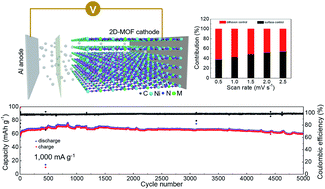Layered metal–organic framework based on tetracyanonickelate as a cathode material for in situ Li-ion storage†
Abstract
Prussian blue analogs (PBAs) formed with hexacyanide linkers have been studied for decades. The framework crystal structure of PBAs mainly benefits from the six-fold coordinated cyano functional groups. In this study, in-plane tetracyanonickelate was utilized to engineer an organic linker and design a family of four-fold coordinated PBAs (FF-PBAs; Fe2+Ni(CN)4, MnNi(CN)4, Fe3+Ni(CN)4, CuNi(CN)4, CoNi(CN)4, ZnNi(CN)4, and NiNi(CN)4), which showed an interesting two-dimensional (2D) crystal structure. It was found that these FF-PBAs could be utilized as cathode materials of Li-ion batteries, and the Ni/Fe2+ system exhibited superior electrochemical properties compared to the others with a capacity of 137.9 mA h g−1 at a current density of 100 mA g−1. Furthermore, after a 5000-cycle long-term repeated charge/discharge measurement, the Ni/Fe2+ system displayed a capacity of 60.3 mA h g−1 with a coulombic efficiency of 98.8% at a current density of 1000 mA g−1. In addition, the capacity of 86.1% was preserved at 1000 mA g−1 as compared with that at 100 mA g−1, implying a good rate capability. These potential capacities can be ascribed to an in situ reduction of Li+ in the interlayer of Ni/Fe2+ instead of the formation of other compounds with the host material according to ex situ XRD characterization. These specially designed FF-PBAs are expected to inspire new concepts in electrochemistry and other applications requiring 2D materials.



 Please wait while we load your content...
Please wait while we load your content...